If you’re trying to create content for your company blog, you need a consistent stream of ideas to fill the pipeline. But where are those ideas supposed to come from? Here, I’ll show you some tricks I use to find blog post ideas that are aligned with my business goals and target audience.
1. Review your customer support logs to find pain points
Use this strategy when you feel like your content isn’t resonating with your target audience
When people write in to customer support, they have a very specific question. If enough people have that question, it likely means it’s worth writing about.
James Parsons, founder and CEO of Content Powered, uses this strategy: “We use a lot of our customer feedback to fuel topic planning. Pain points, questions, and strategies I see them using,” he said. “For example, one of our clients used NitroPack and wanted to know if it was possible to remove the footer link that they add. So, we wrote a blog post about that very subject. It ended up being a big driver of traffic, and we now rank #1 on Google for it.”
But don’t only write tutorial or troubleshooting articles. Those are great, but you should also try to pull themes from the questions, so you can write a variety of posts that speak more generally to customer pain points. To do this, take a step back: look at the questions you’re getting and think about what the underlying goals are. Not just what is your customer asking? but why are they asking that?
If your business doesn’t get too many support tickets (in which case, congratulations), you can always reach out to your existing customers via email, asking them about their pain points. Here’s how I close the welcome email I send when someone subscribes to my fitness newsletter:
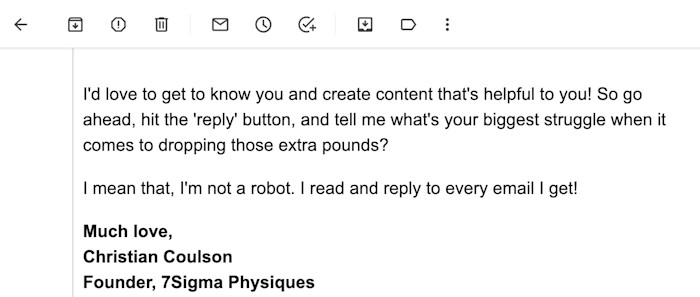
I get all sorts of great responses that have sparked blog post ideas.
Another option is to look at what customers are saying about your product or service on social media. And while you’re there, peek at what your competitors’ customers are saying, as they likely have similar pain points.
2. Use AI software
Use this strategy when you’re just plain stuck
Artificial intelligence (AI) is getting more user-friendly by the day, and while it’s not ready to replace writers and editors quite yet, you can think of it as your inspiration bot.
AI content marketing software uses natural language processing—a branch of AI that helps computers understand, interpret, and manipulate human language—to scan through existing top-performing posts in your niche. Then they analyze the content for certain components, such as keywords and sentence structure, to generate new, unique ideas.
Here are some blog post topic ideas generated by Jarvis AI for my fitness website.
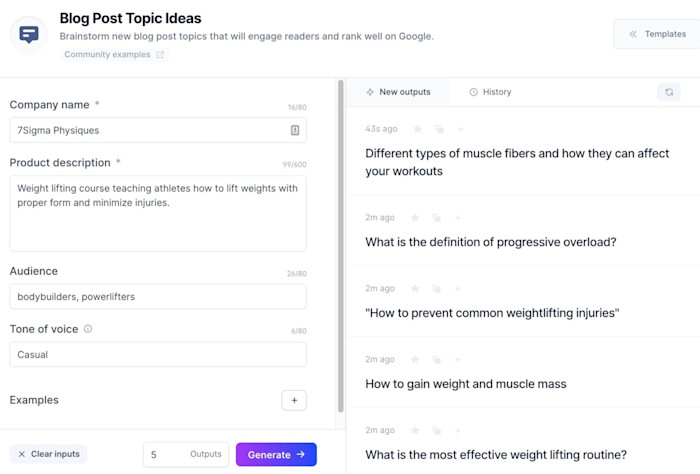
All you need to do is add your company name, product or service description, target audience, and tone of voice—then click a button to have Jarvis generate blog post ideas for your business. I recommend using these ideas as a jumping-off point. Some of them might be excellent and just right for your business, but don’t get sucked into the robots-know-all mindset—remember that you know your customers better than a computer does.
3. Use Google Alerts and Google Trends
Use this strategy when your main goal is to improve your SEO
Google Alerts has been around for a while, but I feel like it’s still an untapped resource for coming up with new ideas.
You tell Google what to search for—basically writing your own search engine queries—and then you’ll get notified (via any app) whenever new content appears on the internet with those terms. It’s an easy and powerful way to stay on top of what’s trending in your industry without having to browse constantly. The more you read about what’s happening in your niche, the more inspiration you’ll have for new content.
You can also put your keywords into Google Trends, and you’ll get suggestions for related trending topics. Say you’re running a pool cleaning company; search “pool cleaning” in Google Trends, and you’ll see other related topics and queries that are increasing in popularity.
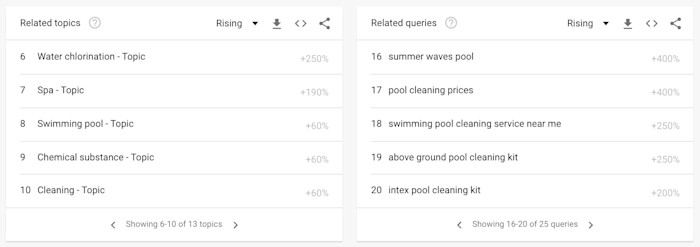
Once you have a topic, you can also use Google Trends to identify when people tend to search for this topic, so you can promote your posts at the right time. Unsurprisingly, the term “pool cleaning” spikes between April and August every year.

4. Study your competitors’ content—and fill in the blanks
Use this strategy when you have a lot of competition in your niche
Your competitors’ content can be a great source of inspiration. You might get ideas just by browsing, or you can grab their URLs and add them to a tool like Google Keyword Planner to find a list of their most relevant and popular keywords, so you can create similar posts based on your own experience or expertise.
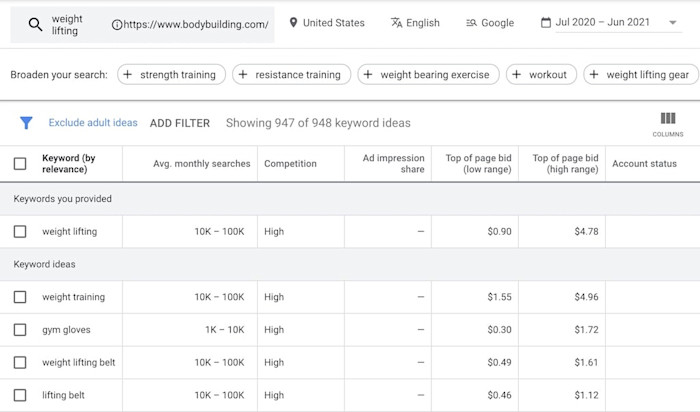
Of course, you can’t just write the same article they did—you need to make yours stand out. So once you have the topics, here’s what you can do to improve on your competitors’ content:
-
Offer more detailed instructions. Here’s an example of a blog post about Pinterest I wrote for Supermetrics that’s ranking second (at the time of writing) for the keyword “Pinterest traffic,” right above another Pinterest piece by Ahrefs, which is a much more popular website. Instead of just telling readers what to do to drive Pinterest traffic, I also give them step-by-step instructions on how to do it.
-
Share experiences instead of just stating facts. Anyone can list facts, but when you combine those with relevant experience, your blog post becomes extremely valuable. For example, in a blog post I wrote for Zapier about optimizing website speed, I share how slow loading times were affecting my business and how each tip mentioned in the article helped improve my performance. This makes the content more relatable.
-
Change up the format. If your competitor’s post is mostly text, try creating useful graphics. Not only does this make your content more engaging, but it also increases your chances of being found through Google’s image search.
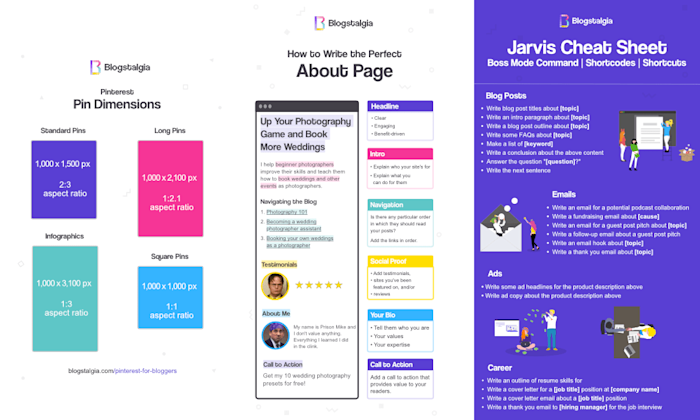
-
Think like a customer. When you approach competitor blog posts with a customer mentality (instead of a competitor mentality), you’ll notice that there are often little pieces missing that prevent you from applying the tips mentioned in the article, types of readers who aren’t being targeted, or opportunity areas that your competitors aren’t serving yet. You could then fill the gaps in their content with your own posts.
5. Join a community for your niche
Use this strategy when you’re just starting out
If you don’t have a ton of customers yet, you might not have a lot of insight into what kinds of content your audience might want. This is when I’d suggest joining an online community for your niche—specifically Facebook Groups and Slack communities.
If you run a fitness-related business, join a fitness Facebook Group. You’ll see conversations and questions from the members pop up, and you can use those as ideas for blog posts.

One important thing to keep in mind: don’t just lurk. You want to introduce yourself, be honest about who you are and what you do, and then join the conversation. Yes, you’re looking for topic ideas, but you should also become a valuable member of the community in the process—which will help the other folks in the group as well as your business.
If you’re more established in your niche, you could even create your own community. The primary effect here will be creating brand advocates, but you’ll also get lots of blog topic ideas in the meantime.
6. Tell your story
Use this strategy if you have a unique origin story
Talking about your struggles and what you learned from them can lead to trust from your audience—and your blog is a great place to share. Instead of the few words you might have in other marketing copy, you have the space to really tell your full story.
On my fitness site, I have a blog post titled “5 Reasons You Keep Regaining Weight and How to Stop It,” where I talk about my own yo-yo dieting journey. I share the story of how I lost 22 pounds in 4 months and then gained 38 pounds in 14 months.

This shows that I can empathize with my readers, and they’re likely to trust me more because of the vulnerability I’ve shown.
7. Take a break
Use this strategy if none of the other ones worked
Sometimes trying to come up with ideas is what’s stopping you from coming up with ideas.
I recommend taking a break and focusing on something else for a while. Spend time with friends or family, watch TV, read a book—the time away will help you re-focus, and you never know where you’ll find inspiration while you’ve stepped away.
[adsanity_group align=’alignnone’ num_ads=1 num_columns=1 group_ids=’15192′]
Need Any Technology Assistance? Call Pursho @ 0731-6725516







